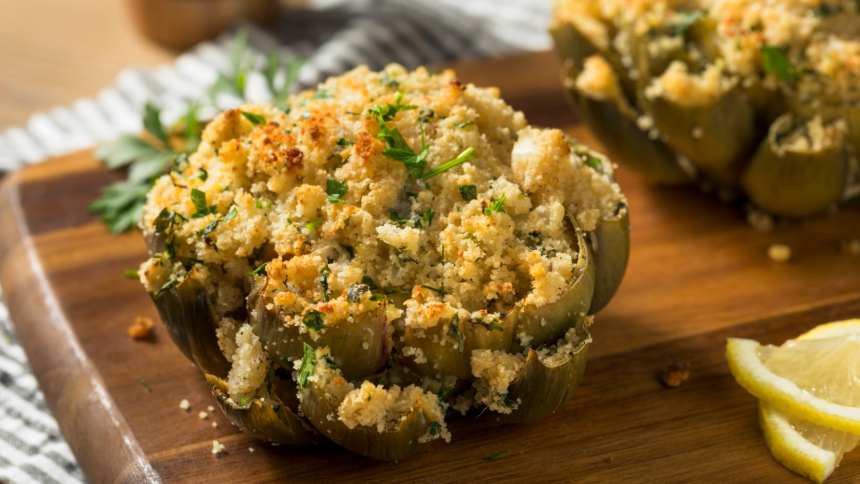
As they pop up increasingly on restaurant menus, you can try before you buy, however. And it’s not as hard to cook with them as you might think – people have been doing it for thousands of years. Let’s get to the heart of artichokes.
Not all artichokes are artichokes
True artichokes are part of the thistle family. More commonly known as globe artichokes in Australia, they are also called French or green artichokes. They look like leathery, layered flower buds because they are – if you don’t pick them when they are young, globe artichokes bloom with purple flowers.
The Jerusalem artichoke, on the other hand, has been misnamed. It is not an artichoke, but part of the sunflower family. Nor is it from Jerusalem; the name comes from the Italian word for sunflower, girasole. While the plant bears bright yellow flower, the edible tuber grows underground and looks like a long knob of ginger or a misshapen potato. We’ll focus on the ‘real’ artichoke.
Artichokes have been eaten for centuries
Descended from North African thistles, globe artichokes – a mixture of Arabic, Spanish and Italian influence loosely meaning are one of the oldest foods known to humans. They were thought to have been first eaten in the Middle East before they were propagated by the Romans. By 80AD, only the rich were allowed to eat artichokes, putting them out of reach of the average person. They were cultivated in Italy in the 15th century before finding favour in France and England, where they were called the heartychock or heartychoke. Artichoke has a complicated etymology, but loosely translates from the Italian articiocco, arti meaning ‘high’ and ciocco ‘stump’. If you’ve spent any time in the Mediterranean, you’ll know how popular they are in that part of the world. Artichokes have been grown in Australia since European settlement but didn’t take off until the wave of Italian migration in the 1940s and 1950s.
They can be grown for food or flowers
The thistle tree can carry about 15 artichokes and grow to about two metres in diameter. They can be grown from seeds or cuttings and are perennials, meaning they will live for several years. (Some of the newer varieties such as the spikeless Global are annuals, so need to be replanted.) They are often grown as ornamentals because their flowers look so striking in bloom. But if you prefer to eat them, make sure you harvest before they open or they will be woody and inedible. Globe artichokes are at their best in Western Australia in spring (the wrongly named tubers are best in autumn). If you’re buying from a market or grocer, look for small to medium tightly packed artichokes with green or purple leaves. They should feel heavy for their size.
Their hearts are the best
The globe appears tough on the outside but underneath this prickly exterior lies a sweet and tender heart, or base, which is what most chefs cook with. The ‘choke’ is the fibrous cluster of white and purple hairs that should be scraped out and discarded before eating. This can be done before cooking if you are slicing them up or stuffing them, or after if you are cooking them whole. Though they are flower buds, artichokes are treated like vegetables and are very versatile. They can be boiled, grilled, barbecued, baked or fried. Artichokes also make great dips, blended with ingredients such as sour cream, garlic and parmesan, and the whole family will love these stuffed baked artichokes.
Artichokes are full of good stuff
Artichokes are packed with nutrients. One artichoke can give you a third of your daily fibre needs and almost 20 percent of the recommended daily Vitamin C intake, which helps protect your immune system. They are also a good source of folate, which helps keep your blood healthy, and potassium and magnesium and are naturally fat free (just note the amount of butter, oil or other fats in your recipe). Artichokes boast plenty of phytonutrients, too, which appear to help detoxify the liver and boost gall bladder function. They are also commonly used in traditional medicine to help relieve digestion issues and stomach acidity.
So what are you waiting for? With a little practice, artichoke hearts are sure to win in a place in yours, too.